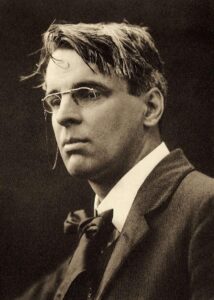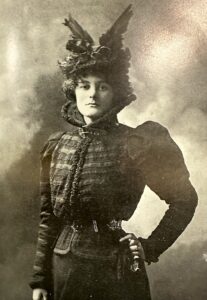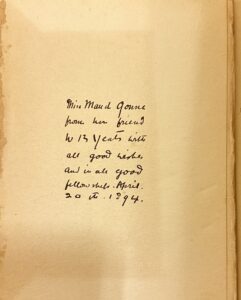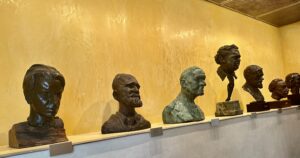William Butler Yeats is one of the most influential poets of the 20th century. Numerous writers, in all genres, who came after him credit the first Irish person to receive the Nobel Prize for Literature (in 1923) for introducing them to the possibility that a poem could hold so much substance if only one knew how to say what they felt as efficiently and eloquently as he.
Other literary critics may agree or disagree with the above but none can deny the monumental influence he has had on 20th century literature. That is, unless that critic happens to be a young teenager in high school learning about him for the first time in 1990s Ireland, as I was.
Almost every high school student on the Emerald Isle was exposed to a significant amount of Yeats’ poetry and prose as a matter of routine. This may sound sublime to many literary enthusiasts in the United States, but to a group of 15-year-old Dubliners, Yeats was considered to be a miserable, dreary Anglo-Irish Protestant aristocrat (the significance of which will be explained later), who, when not complaining about the state of the world, was harping on about ancient characters we teenagers had neither heard of nor seen on TV. Let’s just say you wouldn’t have found any lines of his prose graffitied anywhere in the school toilets.
Ireland has been fortunate to have produced many writers, poets and playwrights who continue to influence and inspire literary enthusiasts centuries after they produced their work, something I’ll admit is a source of great pride for me.
UT and the “Island of Saints and Scholars”
So it was indeed a very pleasant surprise to learn that the Harry Ransom Center at The University of Texas at Austin has made it a top priority to acquire the collections of so many of the most famous Irish heavy hitters, from Jonathan Swift and Oscar Wilde to James Joyce and Samuel Beckett.

You don’t even have to be dead to be appreciated in the Lone Star State. Joseph O’Connor, Anne Enright, Colm Toibín and many other living, breathing scribes continue to uphold this tradition thanks in no small part to the excellent literary taste and aggressive acquisitional activity of the Harry Ransom Center, which holds the collections of all of the aforementioned and several other Irish literary giants too.
But no Irish name carries more weight than Yeats, whose collection here on campus is also formidable. Much of the Yeats collection was acquired by the Ransom Center in the late 1960s from London collections. It consists of 11 boxes and one gallery folder as well as a collection of 844 letters. Among materials by Yeats, are manuscripts for more than 50 works and a collection of 844 letters, many written to other well-known artists, musicians and critics of the time.
Early Life
Yeats was born in Dublin in 1865 to John Butler Yeats and Susan Pollexfen. His father began his career as an aspiring lawyer, much to the delight of his high-society wife, whose mercantile family enjoyed significant standing in their hometown of Sligo in the northwest of Ireland.

Two years into the marriage, however, John Butler Yeats quit the legal profession to become a full-time artist, a move that was not taken well either by his wife or her well-to-do family. To make matters worse for Yeats’ mother, all six of her children followed in their father’s bohemian footsteps, rejecting respectable professional careers for painting, embroidery, poetry and literature.
Yeats and the Theater
W.B. Yeats won the Nobel Prize in Literature in 1923. Facing some stiff competition — including Thomas Hardy and Maxim Gorky — he had in fact been nominated seven times previously. He was the first Irish person to receive the honor, and the judges noted their decision was based on his “always inspired poetry, which in a highly artistic form gives expression to the spirit of a whole nation.”
At 58, Yeats was known primarily for his poetry by the time he received the honor, but he began his artistic career in the world of drama and theater. He co-founded the Irish Theatre, which later became the infamous Abbey Theatre, with fellow playwright Lady Gregory. Yeats’ productions were heavily inspired by ancient Irish legends and folklore combined with broader mystic and spiritual themes. The Countess Cathleen (1892), The Land of Heart’s Desire (1894), Cathleen ni Houlihan (1902), The King’s Threshold (1904) and Deirdre (1907) are among some of his best known plays.
His theatrical work was also rife with mystical and spiritual themes inspired by time he spent in London as a young man during the fin de siècle era. As the industrial age brought rapid change as well as greater interest in science over otherworldly pursuits, Yeats became part of a movement celebrating mysticism, symbolism and spiritualism.
He took these broader themes back to his native Ireland – weaving his interest in Gaelic folklore and the ancient customs of Ireland into the political and social themes that were to become significant in his later career. Through his devotion to legends – many of which survived only through the oral storytelling tradition – Yeats helped preserve much classic Irish folklore that might have been all but forgotten.
Yeats and Poetry
Indulge me dear reader once more as I reminisce about my adolescent disdain for the Nobel Prize-winning artistic giant who helped put the small island of Ireland on the literary map. In high school we were mostly exposed to Yeats’ poetry, rather than his theater where, as mentioned, his stories of the ancient heroes and legends from Irish folklore bored us to tears.
Leis an scéal a dheanamh níos measa (to make matters worse), another theme dominated his poems that frustrated us even more: his love for an admittedly badass woman, the Irish revolutionary hero and actor Maud Gonne. Sadly for the young poet, Gonne was not at all interested in him as a suiter though.

Yeats proposed to Gonne six times over the course of his life. She turned him down six times. At one point he married her daughter in an effort to get closer to his true love. Not cool. He wrote countless poems to her, to no avail. In one such love poem to Gonne, titled “He Wishes His Beloved Were Dead,” Yeats wrote:
Were you but lying cold and dead,
And lights were paling out of the West,
You would come hither, and bend your head,
And I would lay my head on your breast;
And you would murmur tender words,
Forgiving me, because you were dead.
Needless to say, these weren’t the kinds of themes we were all that capable of grasping.
Gonne Girl Gone
Twenty years later, I’ll admit I have matured enough to feel so much more from Yeats’ poetry than I ever could have when I was still mostly obsessed with UK pop band Blur and saving up enough money to buy a Motorola mobile phone the size of a toaster. Art – especially poetry and prose – is most valuable when it challenges the reader to reexamine their own preconceived notions of the human condition.
Yeats’ endlessly futile pages of unrequited love poems to Gonne provide much more of a nuanced understanding of the trials and tribulations of love than, dare I say, Shakespeare’s sonnets, where love grows on trees that bear fruit all year round. It’s almost as if 1609’s quarto was composed entirely using ChatGPT when compared to Yeats’ deep accounts of sadness and despair for the woman he couldn’t have.

Art – especially poetry and prose – is most valuable when it challenges the reader to reexamine their own preconceived notions of the human condition."
Neither English nor Irish but a Citizen of the World
As stated, Yeats was born into the landed Anglo-Irish aristocracy. He was part of a generation of English, Protestant landowners gifted lands in Ireland in an attempt by the English crown to spread their culture and eliminate all things Gaelic and Irish including, most importantly, our native tongue. Again, such a lineage didn’t earn much favor for Yeats from myself or my fellow students raised in a Republican, Catholic, anti-English tradition.
It is important to note, however, that the young W.B. Yeats rejected both Protestantism and Catholicism from a very early age. In addition, his later poetry became increasingly political in tone and was explicitly critical, not just of the treatment of Irish Catholics under English rule but also the growing divide between rich and poor brought on by the Industrial Revolution.
In other words, he used his privileged position to champion the rights of those less fortunate than he, regardless of their race, color or creed.
“September 1913” is one of his most famous overtly political poems. Here he chronicles the Dublin Lockout, one of the largest industrial disputes in Irish history. Approximately 20,000 workers were forced to strike after their employers refused calls to unionize for better conditions. The dispute lasted more than four months, leading to severe hardship for the unemployed workers.
What need you, being come to sense,
But fumble in a greasy till
And add the halfpence to the pence
And prayer to shivering prayer, until
You have dried the marrow from the bone;
For men were born to pray and save:
Romantic Ireland’s dead and gone,
It’s with O’Leary* in the grave.
(*A reference to John O’Leary, an early member of the Irish Republican Brotherhood, a secret organization founded in the 1850s committed to establishing an “independent democratic republic” in Ireland.)
Yeats’ Lasting Legacy
Despite the esoteric themes of ancient Irish folklore, Irish political and social unrest, and his fascination with spiritualism, mysticism and the occult, Yeats still managed to touch the hearts and minds of writers across the world and helped inspire a whole new generation of artists in the 20th century and beyond.
Renowned American poet Robert Bly, who died in 2021, publicly stated that Yeats was the reason he became a poet. In an interview with The New York Times, Bly said, “One day while studying a Yeats poem I decided to write poetry the rest of my life. I recognized that a single short poem has room for history, music, psychology, religious thought, mood, occult speculation, character, and events of one’s own life.”
I recognized that a single short poem has room for history, music, psychology, religious thought, mood, occult speculation, character, and events of one's own life."
The Harry Ransom Center at the University of Texas at Austin is fortunate to have a Yeats collection with material dating from 1870-1970. The poet died in 1939 but the Ransom Center collection also holds important works from Joseph Maunsell Hone (1882-1969), publisher of fine-press books by many poets and dramatists of the Irish Literary Renaissance, who compiled biographies of Yeats and George Moore, as well as English artist Henry Tonks and others. The collection also includes a transcript of the diary of Yeats’ sister, Elizabeth Yeats; an account of Yeats’s philosophical and occult ideas; and remembrances of Yeats written by friends and family. Related items include Hone’s 300-page unpublished manuscript memoir of Maud Gonne (1866-1953).

A series of BBC radio broadcasts on Irish writers (1949-1954) includes taped interviews of poets, novelists and dramatists of the period as well as archival materials.
There is no doubt in my mind that Yeats would’ve been as surprised as I was to discover so much of his original collection residing in Texas. But he is in good company, among the collections of so many other Irish luminaries such as Oscar Wilde, George Bernard Shaw, James Joyce and Samuel Beckett, to name just a few. Y’all have good taste in literature.
Johnny Holden is communications manager in UT’s Office of the Vice President for Research, Scholarship and Creative Endeavors.



